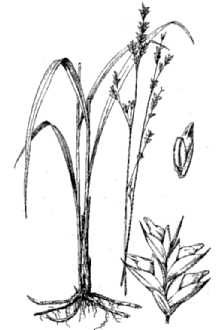Diarrhena americana
| Diarrhena americana | |
|---|---|
 | |
| 1950 drawing[1] | |
| Scientific classification | |
| Kingdom: | Plantae |
| (unranked): | Angiosperms |
| (unranked): | Monocots |
| (unranked): | Commelinids |
| Order: | Poales |
| Family: | Poaceae |
| Genus: | Diarrhena |
| Species: | D. americana |
| Binomial name | |
| Diarrhena americana P.Beauv. 1812 | |
| Synonyms[2] | |
| |
Diarrhena americana, also known as American beak grass or American beakgrain, is a native, perennial bunchgrass of North America. [3] [4]
Historically, Diarrhena americana was the only species of beak grass recognized in the United States; however studies have suggested that the known beak grass is to be classified into two distinct species, Diarrhena americana and Diarrhena obovata.[5]
Distribution
Diarrhena americana naturally occurs throughout the Mid-Western United States, including in eastern Oklahoma and Missouri; south to Alabama; east to Kentucky, the Appalachian Mountains and northern Maryland; and north to southern Illinois, Indiana, Ohio, and southern Michigan. [3][6] [7] [8]
The grass plant lives in rich cove forests and woodlands, preferring to grow in the moist soils of shaded ledges and riverbanks.[9] t grows in rich, moist woodlands from Missouri to Maryland and south to Oklahoma and Alabama.[10]
Description
Diarrhena americana is a bunchgrass that grows in 2–3 feet (0.61–0.91 m) tall clumps. It has bright green leaf blades, that can grow up to 0.75 inches (1.9 cm) in width. [3]
These perennial plants can grow flowers that grow above the foliage, with 3 inch tall floral spikes, during the early to mid-summer. [3][11] [12][13] Culms range from 60–131 cm in height.
By late summer the flowers turn into hard, brown seed heads. [3] Each seed is reduced to a blunt beak, which is where the common name of beak grass comes from, and this beak is dispersed.[14]
Cultivation
Diarrhena americana is cultivated as an ornamental grass, grown in traditional and wildlife gardens, and in natural landscaping projects. [15]
It is considered an easy plant to grow and maintain, not needing much sun or water while generally being a tough plant. It will tolerate: drought, heavy shade, black walnutcompetition, and urban air pollution. [15] When available, the plant will grow into dense clumps in moist rich soils in full shade. "Diarrhena americana". Retrieved 2014-04-25.</ref> Seeds can be bought in stores and online. [16]
Conservation
Diarrhena americana is a listed endangered species in Maryland and Wisconsin, and a threatened species in Michigan.[17]
See also
- Bunchgrasses of North America
References
- ↑ Hitchcock, A.S. (rev. A. Chase). 1950. Manual of the grasses of the United States. USDA Miscellaneous Publication No. 200. Washington, DC.
- ↑ Tropicos, Festuca diandra Michx.
- 1 2 3 4 5 The Grass Manual on the Web.edu: Treatment of Diarrhena americana (American Beakgrain)
- ↑ "Diarrhena americana 'Beauv.'" (PDF). Retrieved 2009-05-30.
- ↑ "A Revision of Diarrhena (Poceae) in the United States" (PDF). Retrieved 2014-04-25.
- ↑ The Grass Manual on the Web.edu: Distribution map for Diarrhena americana
- ↑ "Diarrhena americana 'Beauv.'". Retrieved 2014-04-25.
- ↑ "Beak Grass Diarrhena obovata". Retrieved 2014-04-25.
- ↑ "Diarrhena americana Beauv.". Retrieved 2014-04-25.
- ↑ "Utah State University: Intermountain Herbarium". Retrieved 2010-06-05.
- ↑ "Diarrhena americana". Retrieved 2014-04-25.
- ↑ "Diarrhena americana (American Beak Grass)". Retrieved 2014-04-25.
- ↑ "Diarrhena americana". Retrieved 2014-04-25.
- ↑ "Missouri Botanical Garden plant finder, Diarrhena americana". Retrieved 2014-04-25.
- 1 2 MissouriBotanicalGarden.org: Kemper Center for Home Gardening — Diarrhena americana (American beakgrain)
- ↑ "Diarrhena americana (American Beak Grass)". Retrieved 2014-04-25.
- ↑ "USDA plant database". Retrieved 2009-05-30.
Sources
- Brandenburg, D.M., J.R. Estes, and S.L. Collins. 1991. A revision of Diarrhena (Poaceae) in the United States. Bull. Torrey Bot. Club 118:128–136.
- Koyama, T. and S. Kawano. 1964. Critical taxa of grasses with North American and eastern Asiatic distribution. Canad. J. Bot. 42:859–864.
- Tateoka, T. 1960. Cytology in grass systematics: A critical review. Nucleus (Calcutta) 3:81–110.
External links
- USDA Plants Profile for Diarrhena americana (American beakgrain)
- Photo of herbarium specimen at Missouri Botanical Garden, collected in Missouri in 1990
![]() Data related to Diarrhena americana at Wikispecies
Data related to Diarrhena americana at Wikispecies
| Wikimedia Commons has media related to Diarrhena americana. |